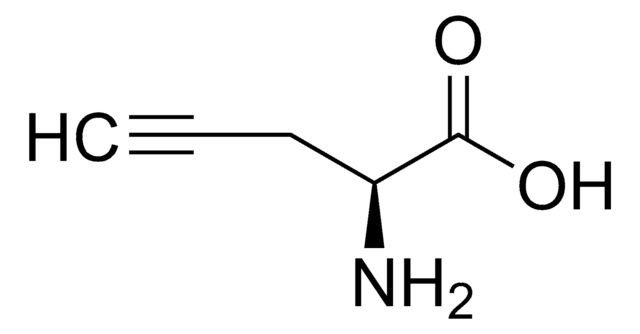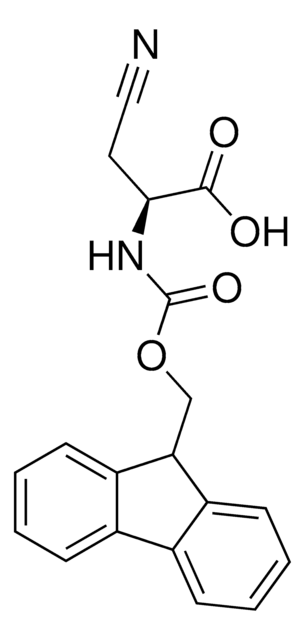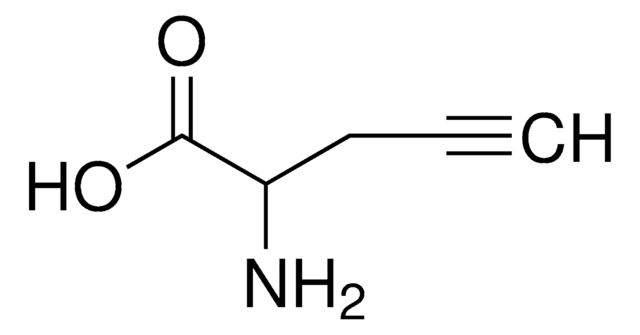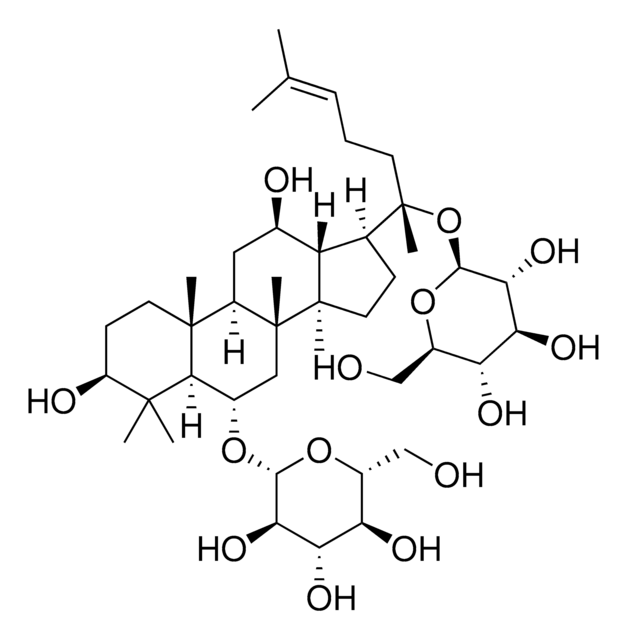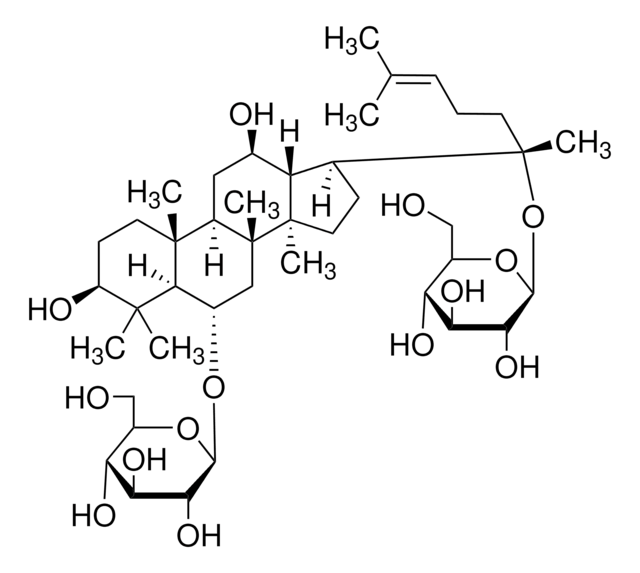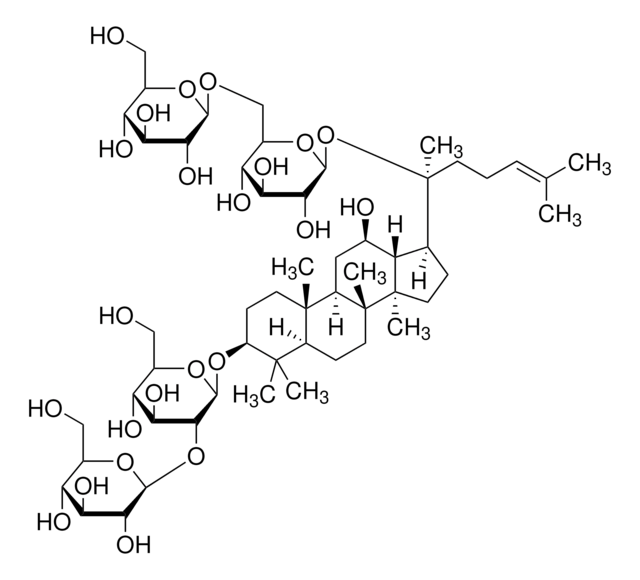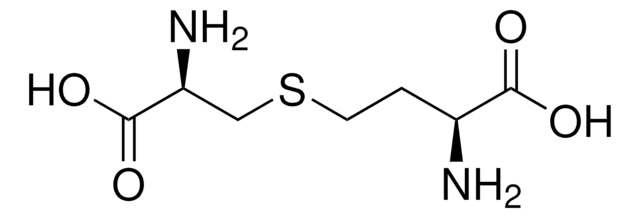Wszystkie zdjęcia(1)
Kluczowe dokumenty
C9650
β-Cyano-L-alanine
≥95%, suitable for ligand binding assays
Synonim(y):
3-cyano-L-alanine
Zaloguj sięWyświetlanie cen organizacyjnych i kontraktowych
About This Item
Wzór empiryczny (zapis Hilla):
C4H6N2O2
Numer CAS:
Masa cząsteczkowa:
114.10
Numer MDL:
Kod UNSPSC:
12352209
Identyfikator substancji w PubChem:
NACRES:
NA.26
Polecane produkty
Nazwa produktu
β-Cyano-L-alanine, ≥95%
Poziom jakości
Próba
≥95%
Formularz
powder
metody
ligand binding assay: suitable
kolor
white
mp
217 °C
temp. przechowywania
−20°C
ciąg SMILES
OC([C@@H](N)CC#N)=O
InChI
1S/C4H6N2O2/c5-2-1-3(6)4(7)8/h3H,1,6H2,(H,7,8)/t3-/m0/s1
Klucz InChI
BXRLWGXPSRYJDZ-VKHMYHEASA-N
Szukasz podobnych produktów? Odwiedź Przewodnik dotyczący porównywania produktów
Działania biochem./fizjol.
β-Cyano-L-alanine (BCA) is used as a cystathione γ-lyase (CSE) inhibitor to study the physiological roles of hydrogen sulfide in processes such as angiogenesis and hypertension.
Ta strona może zawierać tekst przetłumaczony maszynowo.
Kod klasy składowania
11 - Combustible Solids
Klasa zagrożenia wodnego (WGK)
WGK 3
Temperatura zapłonu (°F)
Not applicable
Temperatura zapłonu (°C)
Not applicable
Wybierz jedną z najnowszych wersji:
Masz już ten produkt?
Dokumenty związane z niedawno zakupionymi produktami zostały zamieszczone w Bibliotece dokumentów.
Andrew G S Warrilow et al.
Journal of experimental botany, 53(368), 439-445 (2002-02-16)
The reaction mechanisms of three enzymes belonging to a single gene family are compared: a cyanoalanine synthase and two isoforms of O-acetylserine (thiol) lyase (O-ASTL) isolated from spinach (Spinacea oleracea L. cv. Medina). O-ASTL represents a major regulatory point in
Markus Piotrowski et al.
Plant molecular biology, 61(1-2), 111-122 (2006-06-21)
Cyanoalanine hydratase (E.C. 4.2.1.65) is an enzyme involved in the cyanide detoxification pathway of higher plants and catalyzes the hydrolysis of beta-cyano-L-alanine to asparagine. We have isolated the enzyme from seedlings of blue lupine (Lupinus angustifolius) to obtain protein sequence
B Teague et al.
British journal of pharmacology, 137(2), 139-145 (2002-09-05)
1. Sodium hydrogen sulphide (NaHS), a donor of hydrogen sulphide (H(2)S), produced dose-related relaxation of the rabbit isolated ileum (EC(50), 76.4+/-7.9 microM) and rat vas deferens (EC(50), 64.8+/-5.4 microM) and reduced ACh-mediated contraction of the guinea-pig isolated ileum. 2. NaHS
Mariarosaria Bucci et al.
Arteriosclerosis, thrombosis, and vascular biology, 30(10), 1998-2004 (2010-07-17)
Recent studies have demonstrated that hydrogen sulfide (H(2)S) is produced within the vessel wall from L-cysteine regulating several aspects of vascular homeostasis. H(2)S generated from cystathione γ-lyase (CSE) contributes to vascular tone; however, the molecular mechanisms underlying the vasorelaxing effects
M Piotrowski et al.
The Journal of biological chemistry, 276(4), 2616-2621 (2000-11-04)
Nitrilases (nitrile aminohydrolases, EC ) are enzymes that catalyze the hydrolysis of nitriles to the corresponding carbon acids. Among the four known nitrilases of Arabidopsis thaliana, the isoform NIT4 is the most divergent one, and homologs of NIT4 are also
Nasz zespół naukowców ma doświadczenie we wszystkich obszarach badań, w tym w naukach przyrodniczych, materiałoznawstwie, syntezie chemicznej, chromatografii, analityce i wielu innych dziedzinach.
Skontaktuj się z zespołem ds. pomocy technicznej